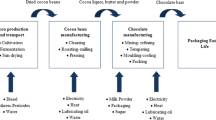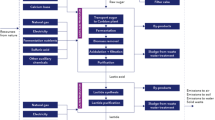Abstract
In this research, the environmental profile of sugar produced from beet was estimated by considering the beet cultivation and the milling process in the Iranian Hamadan Province via the life cycle assessment methodology. Data were obtained from sugar beet growers and the main sugar mill in the province. The system boundaries were set from the sugar beet planting to the production of white sugar in the sugar mill. The functional unit was considered to be 1 ton of white sugar. The calculations were performed for impact categories including global warming, abiotic depletion, fossil fuel depletion, ozone layer depletion, human toxicity, fresh water aquatic ecotoxicity, marine aquatic ecotoxicity, terrestrial ecotoxicity, photochemical oxidation, acidification, and eutrophication. Results indicate that the global warming impact of sugar production through beet cultivation and the milling process was estimated to be 310, and 1540 kgCO2eq/ton, respectively. Electricity accounted for the greatest share of the impact for agricultural phase (55.29%), followed by chemical fertilisers (20.83%). This electricity consumption in sugar beet production is mainly due to the agricultural irrigation. Therefore, the enhancement of water use efficiency and water extraction in sugar beet farming seems to be a possible solution to the reduction of the overall environmental burden. Also, sugar beet production should become more efficient in terms of fertiliser use. In the industrial phase, the most significant impacts are related to the production and use of natural gas. Renovation of equipment and development of renewable energies in the mill have been suggested for making beet processing more energy efficient.





Similar content being viewed by others
Data availability
Not applicable.
Code availability
Not applicable.
Abbreviations
- ADP:
-
Abiotic depletion potential
- AFDP:
-
Abiotic depletion potential (fossil fuels)
- GWP:
-
Global warming potential
- ODP:
-
Ozone depletion potential
- HTP:
-
Human toxicity potential
- FAWP:
-
Fresh water aquatic ecotoxicity potential
- MAEP:
-
Marine aquatic ecotoxicity potential
- TEP:
-
Terrestrial ecotoxicity potential
- POP:
-
Photochemical oxidation potential
- AP:
-
Acidification potential
- EP:
-
Eutrophication potential
- FU:
-
Functional unit
- LCA:
-
Life cycle assessment
- LCI:
-
Life cycle inventory
- LCIA:
-
Life cycle impact assessment
- SD:
-
Standard deviation
- VSD:
-
Variable speed drives
- tkm:
-
Ton kilometre
References
Hossain MS, Arshad M, Qian L, Kächele H, Khan I, Islam MDI, Mahboob MG (2020) Climate change impacts on farmland value in Bangladesh. Ecol Ind 112:106–181
Notarnicola B, Tassielli G, Renzulli PA, Monforti F (2017) Energy flows and greenhouses gases of EU (European Union) national breads using an LCA (Life Cycle Assessment) approach. J Clean Prod 140:455–469
FAO (2022) FAOSTAT Statistical Database. The Food and Agriculture Organization of the United Nations, Rome. Available on-line: www.fao.org/faostat/en/#home. Accessed 20 Feb 2022
MAJ (2022) Annual Agricultural Statistics. Retrieved from: www.maj.ir. Accessed 20 Feb 2022
Cheesman OD (2004) Environmental impacts of sugar production: the cultivation and processing of sugarcane and sugar beet. CABI Publication, UK
Notarnicola B, Sala S, Anton A, McLaren SJ, Saouter E, Sonesson U (2017) The role of life cycle assessment in supporting sustainable agri-food systems: a review of the challenges. J Clean Prod 140:399–409
Bosco S, Di Bene C, Galli M, Remorini D, Massai R, Bonari E (2011) Greenhouse gas emissions in the agricultural phase of wine production in the Maremma rural district in Tuscany, Italy. Ital J Agron 6(e15):93–100
Brentrup F, Küsters J, Kuhlmann H, Lammel J (2004) Environmental impact assessment of agricultural production systems using the life cycle assessment methodology: I Theoretical concept of a LCA method tailored to crop production. Eur J Agron 20(3):247–264
Gholamrezaee H, Kheiralipour K, Rafiee S (2021) Investigation of energy and environmental indicators in sugar production from sugar beet. J Environ Sci Stud 6(2):3540–3548
Marashi F, JafarzadehHaghighifard N, Khorasani N, Monavari SM (2019) Life cycle assessment of the sugar industry: a case study of Amir Kabir sugar cane industry. Iran J Biosyst Eng 49(4):597–608
Renouf M, Wegener M, Nielsen L (2008) An environmental life cycle assessment comparing Australian sugarcane with US corn and UK sugar beet as producers of sugars for fermentation. Biomass Bioenerg 32(12):1144–1155
Meza-Palacios R, Aguilar-Lasserre AA, Morales-Mendoza LF, Pérez-Gallardo JR, Rico-Contreras JO, Avarado-Lassman A (2019) Life cycle assessment of cane sugar production: the environmental contribution to human health, climate change, ecosystem quality and resources in México. J Environ Sci Health, Part A 54(7):668–678
Ramjeawon T (2004) Life cycle assessment of cane-sugar on the island of Mauritius. Int J Life Cycle Assess 9(4):254–260
Mashoko L, Mbohwa C, Thomas VM (2010) LCA of the South African sugar industry. J Environ Planning Manage 53(6):793–807
Yadav SK, Mishra GC (2013) Environmental life cycle assessment framework for Sukker production (raw sugar production). Int J Environ Eng Manag 4(5):499–506
Shukla A, Kumar DSY (2017) A Review on Exergy, Life cycle and thermo economic analysis of sugar industry, International Journal of Mechanical. Eng Technol 8(10):108–119
Seabra JE, Macedo IC, Chum HL, Faroni CE, Sarto CA (2011) Life cycle assessment of Brazilian sugarcane products: GHG emissions and energy use. Biofuels, Bioprod Biorefin 5(5):519–532
Hiloidhari M, Banerjee R, Rao AB (2021) Life cycle assessment of sugar and electricity production under different sugarcane cultivation and cogeneration scenarios in India. J Clean Prod 290:125170
Renouf MA, Wegener MK, Pagan RJ (2010) Life cycle assessment of Australian sugarcane production with a focus on sugarcane growing. Int J Life Cycle Assess 15(9):927–937
Ghani HU, Gheewala SH (2018) Comparative life cycle assessment of byproducts from sugarcane industry in Pakistan based on biorefinery concept. Biomass Convers Biorefinery 8(4):979–990
Kaab A, Sharifi M, Mobli H, Nabavi-Pelesaraei A, Chau K-W (2019) Combined life cycle assessment and artificial intelligence for prediction of output energy and environmental impacts of sugarcane production. Sci Total Environ 664:1005–1019
Brentrup F, Küsters J, Kuhlmann H, Lammel J (2001) Application of the life cycle assessment methodology to agricultural production: an example of sugar beet production with different forms of nitrogen fertilisers. Eur J Agron 14(3):221–233
Bazrgar AB, Soltani A, Koocheki A, Zeinali E, Ghaemi A (2011) Environmental emissions profile of different sugar beet cropping systems in East of Iran. Afr J Agric Res 6(29):6246–6255
Tahmasebi E, Bozorgi M, Khukhan K (2013) Sugar beet ecological emissions profile in East of Iran. Front Agric Food Technol 1(4):34–43
Bennett R, Phipps R, Strange A, Grey P (2004) Environmental and human health impacts of growing genetically modified herbicide-tolerant sugar beet: a life-cycle assessment. Plant Biotechnol J 2(4):273–278
Soheili-Fard F, Kouchaki-Penchah H (2015) Assessing environmental burdens of sugar beet production in East Azerbaijan province of IR Iran based on farms size levels. Int J Farm Allied Sci 4(5):489–495
ISO (2006a) ISO 14040:2006. Environmental management-life cycle assessment-principles and framework. International Organization for Standardisation, Geneva
ISO (2006b) ISO 14044:2006. Environmental management - life cycle assessment - requirements and guidelines. International Organization for Standardisation, Geneva
Khoram MR, Safikhani M, Khezri SM (2013) Review of Hosein Aabad Sugar Factory (HASF) wastewater and assessment of its pollution load. J Appl Sci Environ Manag 17(3):395–400
Mousavi-Avval SH, Rafiee S, Jafari A, Mohammadi A (2011) The functional relationship between energy inputs and yield value of soybean production in Iran. Int J Green Energy 8(3):398–410
IPCC (2006) IPCC guidelines for national greenhouse gas inventories. Available on-line: https://www.ipcc-nggip.iges.or.jp/public/2006gl/. Accessed 15 Feb 2022
Sutter J (2010) Final Report: Life Cycle Inventories of Pesticides. Swiss Centre for Life Cycle Inventories, St. Gallen, Switzerland
Nemecek T, Kägi T, Blaser S (2007) Life cycle inventories of agricultural production systems. Final report ecoinvent V. 2.0 No 15a. Swiss Centre for Life Cycle Inventories, Dübendorf, Switzerland. Retrieved from: www.ecoinvent.ch. Accessed 15 Feb 2022
Mousavi-Avval SH, Rafiee S, Sharifi M, Hosseinpour S, Notarnicola B, Tassielli G, Renzulli PA (2017) Application of multi-objective genetic algorithms for optimization of energy, economics and environmental life cycle assessment in oilseed production. J Clean Prod 140:804–815
Brentrup F, Küsters J, Lammel J, Kuhlmann H (2000) Methods to estimate on-field nitrogen emissions from crop production as an input to LCA studies in the agricultural sector. Int J Cycle Assess 5(6):349–357
Yuttitham M, Gheewala SH, Chidthaisong A (2011) Carbon footprint of sugar produced from sugarcane in eastern Thailand. J Clean Prod 19(17–18):2119–2127
Spoerri A, Kägi T (2016) Case study European sugar: important insights for environmental footprinting. In proceedings of 10th International Conference on Life Cycle Assessment of Food, Dublin, Ireland. 19–21 October 2016
Soltanpanahi S, Prakash Kammardi T, Ghaderzadeh H (2013) Analysis of input-output energy use in sugar beet production in Iran. World Appl Sci J 28(9):1252–1261
Erdal G, Esengün K, Erdal H, Gündüz O (2007) Energy use and economical analysis of sugar beet production in Tokat province of Turkey. Energy 32(1):35–41
Soltani A, Rajabi M, Zeinali E, Soltani E (2011) Evaluation of environmental impact of crop production using LCA: wheat in Gorgan. J Crop Prod 3(3):201–218
Moore PH (2017) Sugarcane and Sugarbeet. In: Thomas B, Murray BG, Murphy DJ (eds) Encyclopedia of Applied Plant Sciences (Second Edition). Academic Press, Oxford, pp 273–280
Duraisam R, Salelgn K, Berekete AK (2017) Production of beet sugar and bio-ethanol from sugar beet and it bagasse: a review. Int J Eng Trends Technol 43(4):222–233
Rahimian B (2015) Application of computational intelligence techniques for determination of economic, energy and environmental indices of wheat, sugar beet and peas production in West of Azerbaijan Province. Dissertation, University of Tehran
Khoshnevisan B, Rajaeifar MA, Clark S, Shamahirband S, Anuar NB, Shuib NLM, Gani A (2014) Evaluation of traditional and consolidated rice farms in Guilan Province, Iran, using life cycle assessment and fuzzy modeling. Sci Total Environ 481:242–251
Yousefi M, Khoramivafa M, Mondani F (2014) Integrated evaluation of energy use, greenhouse gas emissions and global warming potential for sugar beet (Beta vulgaris) agroecosystems in Iran. Atmos Environ 92:501–505
Nabavi-Pelesaraei A, Amid S, Shoja H (2014) Energy use and greenhouse gas emission analysis for sugar beet production under three cultivated area levels. Trend Life Sci 3(2):10–22
Crutzen PJ, Mosier AR, Smith KA, Winiwarter W (2008) N2O release from agro-biofuel production negates global warming reduction by replacing fossil fuels. Atmos Chem Phys 8:389–395
Hillier J, Hawes C, Squire G, Hilton A, Wale S, Smith P (2009) The carbon footprints of food crop production. Int J Agric Sustain 7(2):107–118
Draycott AP, Christenson DR (2003) Nutrients for sugar beet production: soil-plant relationships. CABI Publication, Wallingford
Solomon SK (2005) Environmental pollution and its management in sugar industry in India: an appraisal. Sugar tech 7(1):77–81
Vaccari G, Tamburini E, Sgualdino G, Urbaniec K, Klemeš J (2005) Overview of the environmental problems in beet sugar processing: possible solutions. J Clean Prod 13(5):499–507
Author information
Authors and Affiliations
Contributions
Majid Namdari: conceptualisation, methodology, formal analysis, investigation, and writing—original draft preparation; Shahin Rafiee: investigation, conceptualisation and supervision; Bruno Notarnicola: formal analysis and supervision; Giuseppe Tassielli: formal analysis, resources and conceptualisation; Pietro A. Renzulli: formal analysis; and reviewing and editing; Soleiman Hosseinpour: formal analysis.
Corresponding author
Ethics declarations
Institutional Review Board statement
Not applicable.
Conflict of interest
The authors declare no competing interests.
Additional information
Publisher's note
Springer Nature remains neutral with regard to jurisdictional claims in published maps and institutional affiliations.
Rights and permissions
About this article
Cite this article
Namdari, M., Rafiee, S., Notarnicola, B. et al. Use of LCA indicators to assess Iranian sugar production systems: case study — Hamadan Province. Biomass Conv. Bioref. 14, 6759–6772 (2024). https://doi.org/10.1007/s13399-022-02982-4
Received:
Revised:
Accepted:
Published:
Issue Date:
DOI: https://doi.org/10.1007/s13399-022-02982-4




